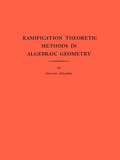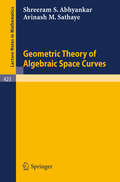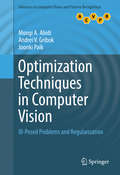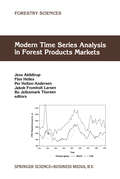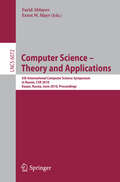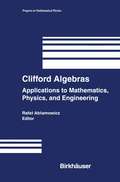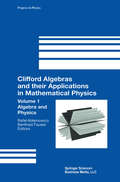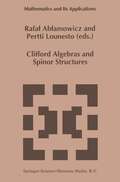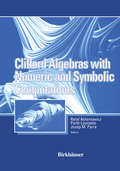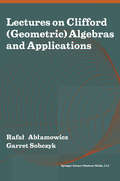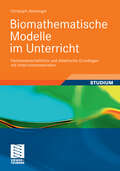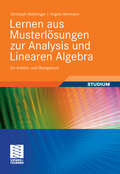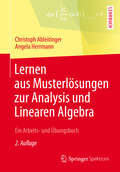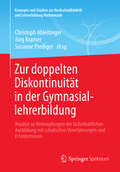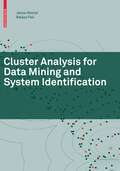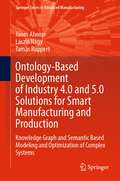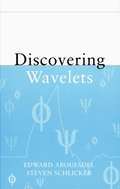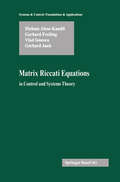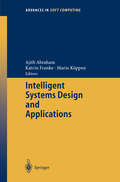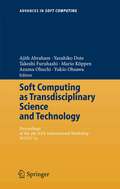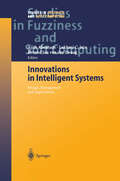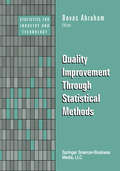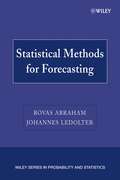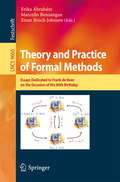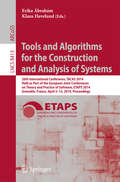- Table View
- List View
Ramification Theoretic Methods in Algebraic Geometry (AM-43), Volume 43
by Shreeram Shankar AbhyankarThe description for this book, Ramification Theoretic Methods in Algebraic Geometry (AM-43), Volume 43, will be forthcoming.
Geometric Theory of Algebraic Space Curves (Lecture Notes in Mathematics #423)
by S.S. Abhyankar A.M. SathayeOptimization Techniques in Computer Vision: Ill-Posed Problems and Regularization (Advances in Computer Vision and Pattern Recognition)
by Mongi A. Abidi Andrei V. Gribok Joonki PaikThis book presents practical optimization techniques used in image processing and computer vision problems. Ill-posed problems are introduced and used as examples to show how each type of problem is related to typical image processing and computer vision problems. Unconstrained optimization gives the best solution based on numerical minimization of a single, scalar-valued objective function or cost function. Unconstrained optimization problems have been intensively studied, and many algorithms and tools have been developed to solve them. Most practical optimization problems, however, arise with a set of constraints. Typical examples of constraints include: (i) pre-specified pixel intensity range, (ii) smoothness or correlation with neighboring information, (iii) existence on a certain contour of lines or curves, and (iv) given statistical or spectral characteristics of the solution. Regularized optimization is a special method used to solve a class of constrained optimization problems. The term regularization refers to the transformation of an objective function with constraints into a different objective function, automatically reflecting constraints in the unconstrained minimization process. Because of its simplicity and efficiency, regularized optimization has many application areas, such as image restoration, image reconstruction, optical flow estimation, etc.Optimization plays a major role in a wide variety of theories for image processing and computer vision. Various optimization techniques are used at different levels for these problems, and this volume summarizes and explains these techniques as applied to image processing and computer vision.
Modern Time Series Analysis in Forest Products Markets (Forestry Sciences #58)
by Jens Abildtrup F. Helles Per Holten-Andersen Jakob Fromholt Larsen Bo Jellesmark ThorsenComputer Science -- Theory and Applications: 5th International Computer Science Symposium in Russia, CSR 2010, Kazan, Russia, June 16-20, 2010, Proceedings (Lecture Notes in Computer Science #6072)
by Farid M. Ablaev Ernst W. MayrClifford Algebras: Applications to Mathematics, Physics, and Engineering (Progress in Mathematical Physics #34)
by Rafal AblamowiczThe invited papers in this volume provide a detailed examination of Clifford algebras and their significance to analysis, geometry, mathematical structures, physics, and applications in engineering. While the papers collected in this volume require that the reader possess a solid knowledge of appropriate background material, they lead to the most current research topics. With its wide range of topics, well-established contributors, and excellent references and index, this book will appeal to graduate students and researchers.
Clifford Algebras and their Applications in Mathematical Physics: Volume 1: Algebra and Physics (Progress in Mathematical Physics #18)
by Rafal Ablamowicz Bertfried FauserThe plausible relativistic physical variables describing a spinning, charged and massive particle are, besides the charge itself, its Minkowski (four) po sition X, its relativistic linear (four) momentum P and also its so-called Lorentz (four) angular momentum E # 0, the latter forming four trans lation invariant part of its total angular (four) momentum M. Expressing these variables in terms of Poincare covariant real valued functions defined on an extended relativistic phase space [2, 7J means that the mutual Pois son bracket relations among the total angular momentum functions Mab and the linear momentum functions pa have to represent the commutation relations of the Poincare algebra. On any such an extended relativistic phase space, as shown by Zakrzewski [2, 7], the (natural?) Poisson bracket relations (1. 1) imply that for the splitting of the total angular momentum into its orbital and its spin part (1. 2) one necessarily obtains (1. 3) On the other hand it is always possible to shift (translate) the commuting (see (1. 1)) four position xa by a four vector ~Xa (1. 4) so that the total angular four momentum splits instead into a new orbital and a new (Pauli-Lubanski) spin part (1. 5) in such a way that (1. 6) However, as proved by Zakrzewski [2, 7J, the so-defined new shifted four a position functions X must fulfill the following Poisson bracket relations: (1.
Clifford Algebras and Spinor Structures: A Special Volume Dedicated to the Memory of Albert Crumeyrolle (1919–1992) (Mathematics and Its Applications #321)
by Rafal Ablamowicz P. LounestoThis volume is dedicated to the memory of Albert Crumeyrolle, who died on June 17, 1992. In organizing the volume we gave priority to: articles summarizing Crumeyrolle's own work in differential geometry, general relativity and spinors, articles which give the reader an idea of the depth and breadth of Crumeyrolle's research interests and influence in the field, articles of high scientific quality which would be of general interest. In each of the areas to which Crumeyrolle made significant contribution - Clifford and exterior algebras, Weyl and pure spinors, spin structures on manifolds, principle of triality, conformal geometry - there has been substantial progress. Our hope is that the volume conveys the originality of Crumeyrolle's own work, the continuing vitality of the field he influenced, and the enduring respect for, and tribute to, him and his accomplishments in the mathematical community. It isour pleasure to thank Peter Morgan, Artibano Micali, Joseph Grifone, Marie Crumeyrolle and Kluwer Academic Publishers for their help in preparingthis volume.
Clifford Algebras with Numeric and Symbolic Computations
by Rafal Ablamowicz Joseph Parra Pertti LounestoThis edited survey book consists of 20 chapters showing application of Clifford algebra in quantum mechanics, field theory, spinor calculations, projective geometry, Hypercomplex algebra, function theory and crystallography. Many examples of computations performed with a variety of readily available software programs are presented in detail.
Lectures on Clifford (Geometric) Algebras and Applications
by Rafal Ablamowicz Garret SobczykThe subject of Clifford (geometric) algebras offers a unified algebraic framework for the direct expression of the geometric concepts in algebra, geometry, and physics. This bird's-eye view of the discipline is presented by six of the world's leading experts in the field; it features an introductory chapter on Clifford algebras, followed by extensive explorations of their applications to physics, computer science, and differential geometry. The book is ideal for graduate students in mathematics, physics, and computer science; it is appropriate both for newcomers who have little prior knowledge of the field and professionals who wish to keep abreast of the latest applications.
Biomathematische Modelle im Unterricht: Fachwissenschaftliche und didaktische Grundlagen mit Unterrichtsmaterialien
by Christoph AbleitingerViele gesellschaftspolitische Themen der vergangenen Jahre stehen in enger Verbindung zum Gebiet der Biomathematik. Das Problem des Generationenvertrages, die Ausbreitung von Epidemien, das Aussterben mancher Tierarten wie auch die Mechanismen der Evolution können durch mathematische Modelle beschrieben und erklärt werden. Das vorliegende Buch integriert diese Themen in einen modernen, anwendungsorientierten und didaktisch reflektierten Mathematikunterricht. Neben der umfassenden Behandlung der mathematischen und didaktischen Grundlagen wird je ein ausführlicher, direkt in der Klasse umsetzbarer Unterrichtsvorschlag zu den Themen Demographie, Populationsgenetik, Ökologie und Epidemiologie gemacht. Das Buch enthält zudem Aufgaben mit Lösungen.
Lernen aus Musterlösungen zur Analysis und Linearen Algebra: Ein Arbeits- und Übungsbuch
by Christoph Ableitinger Angela HerrmannDie Bewältigung des Grundstudiums Mathematik entscheidet sich größtenteils am erfolgreichen Lösen der gestellten Übungsaufgaben. Dies erfordert jedoch eine Professionalität, in die Studierende erst langsam hineinwachsen müssen. Das vorliegende Buch möchte sie bei diesem Prozess unterstützen. Es schafft Vorbilder in Gestalt ausführlicher Musterlösungen zu typischen Aufgaben aus Analysis und Lineare Algebra. Zusätzlich liefert es Anleitungen, wesentliche Strategien und Techniken zu verstehen, einzuüben und zu reflektieren.
Lernen aus Musterlösungen zur Analysis und Linearen Algebra: Ein Arbeits- und Übungsbuch
by Christoph Ableitinger Angela HerrmannDie Bewältigung des Grundstudiums Mathematik entscheidet sich größtenteils am erfolgreichen Lösen der gestellten Übungsaufgaben. Dies erfordert jedoch eine Professionalität, in die Studierende erst langsam hineinwachsen müssen. Das vorliegende Buch möchte sie bei diesem Prozess unterstützen. Es schafft Vorbilder in Gestalt ausführlicher Musterlösungen zu typischen Aufgaben aus der Analysis und der Linearen Algebra. Zusätzlich liefert es Anleitungen, wesentliche Strategien und Techniken zu verstehen, einzuüben und zu reflektieren. Das Buch hat den Anspruch, die kompletten Lösungswege inklusive der Ideengewinnung und etwaiger Alternativen darzustellen. Im Übungsteil wird das Hin- und Herschalten zwischen komprimierten und ausführlichen Musterlösungen geschult. In der vorliegenden Neuauflage wurde ein Kapitel mit Musterlösungen eingefügt, die sich mit Grundlagen mathematischen Arbeitens beschäftigen.
Zur doppelten Diskontinuität in der Gymnasiallehrerbildung: Ansätze zu Verknüpfungen der fachinhaltlichen Ausbildung mit schulischen Vorerfahrungen und Erfordernissen (Konzepte und Studien zur Hochschuldidaktik und Lehrerbildung Mathematik)
by Christoph Ableitinger Jürg Kramer Susanne PredigerAusgehend von Problemanalysen zur doppelten Diskontinuität der Lehramtsausbildung sind in den letzten Jahren an vielen Standorten Konzepte entwickelt worden für sinnstiftende Anfangsveranstaltungen und die Aufbereitung der fachlichen Inhalte für späteres didaktisches Handeln zwischen fachinhaltlichen und fachdidaktischen Ausbildungselementen. Der Sammelband gibt einen Überblick zu unterschiedlichen Konzepten und ihrer Umsetzung in Lehrveranstaltungen, um didaktische und methodische Ansätze ("good practice") möglichst konkret vorzustellen und dahinter stehende Prinzipien zu reflektieren und zu konsolidieren.
Cluster Analysis for Data Mining and System Identification
by János Abonyi Balázs FeilThe aim of this book is to illustrate that advanced fuzzy clustering algorithms can be used not only for partitioning of the data. It can also be used for visualization, regression, classification and time-series analysis, hence fuzzy cluster analysis is a good approach to solve complex data mining and system identification problems. This book is oriented to undergraduate and postgraduate and is well suited for teaching purposes.
Ontology-Based Development of Industry 4.0 and 5.0 Solutions for Smart Manufacturing and Production: Knowledge Graph and Semantic Based Modeling and Optimization of Complex Systems (Springer Series in Advanced Manufacturing)
by János Abonyi László Nagy Tamás RuppertThis book presents a comprehensive framework for developing Industry 4.0 and 5.0 solutions through the use of ontology modeling and graph-based optimization techniques. With effective information management being critical to successful manufacturing processes, this book emphasizes the importance of adequate modeling and systematic analysis of interacting elements in the era of smart manufacturing. The book provides an extensive overview of semantic technologies and their potential to integrate with existing industrial standards, planning, and execution systems to provide efficient data processing and analysis. It also investigates the design of Industry 5.0 solutions and the need for problem-specific descriptions of production processes, operator skills and states, and sensor monitoring in intelligent spaces. The book proposes that ontology-based data can efficiently represent enterprise and manufacturing datasets. The book is divided into two parts: modeling and optimization. The semantic modeling part provides an overview of ontologies and knowledge graphs that can be used to create Industry 4.0 and 5.0 applications, with two detailed applications presented on a reproducible industrial case study. The optimization part of the book focuses on network science-based process optimization and presents various detailed applications, such as graph-based analytics, assembly line balancing, and community detection. The book is based on six key points: the need for horizontal and vertical integration in modern industry; the potential benefits of integrating semantic technologies into ERP and MES systems; the importance of optimization methods in Industry 4.0 and 5.0 concepts; the need to process large amounts of data while ensuring interoperability and re-usability factors; the potential for digital twin models to model smart factories, including big data access; and the need to integrate human factors in CPSs and provide adequate methods to facilitate collaboration and support shop floor workers.
Discovering Wavelets
by Edward Aboufadel Steven SchlickerAn accessible and practical introduction to wavelets With applications in image processing, audio restoration, seismology, and elsewhere, wavelets have been the subject of growing excitement and interest over the past several years. Unfortunately, most books on wavelets are accessible primarily to research mathematicians. Discovering Wavelets presents basic and advanced concepts of wavelets in a way that is accessible to anyone with only a fundamental knowledge of linear algebra. The basic concepts of wavelet theory are introduced in the context of an explanation of how the FBI uses wavelets to compress fingerprint images. Wavelet theory is further developed in the setting of function spaces. The book then moves on to present more advanced topics such as filters, multiresolution analysis, Daubechies' wavelets, and further applications. The book concludes with a series of projects and problems that introduce advanced topics and offer starting points for research. Sample projects that demonstrate real wavelet applications include image compression, a wavelet-based search engine, processing with Daubechies' wavelets, and more. Among the special features of Discovering Wavelets are: * Real-life, hands-on examples that involve actual wavelet applications * A companion Web site containing Pixel Images software and Maple files to be used with the projects in the book * Challenging problems that reinforce and expand on the ideas being developed * An appendix containing the linear algebra needed to understand wavelets as presented in the book
Matrix Riccati Equations in Control and Systems Theory (Systems & Control: Foundations & Applications)
by Hisham Abou-Kandil Gerhard Freiling Vlad Ionescu Gerhard JankThe authors present the theory of symmetric (Hermitian) matrix Riccati equations and contribute to the development of the theory of non-symmetric Riccati equations as well as to certain classes of coupled and generalized Riccati equations occurring in differential games and stochastic control. The volume offers a complete treatment of generalized and coupled Riccati equations. It deals with differential, discrete-time, algebraic or periodic symmetric and non-symmetric equations, with special emphasis on those equations appearing in control and systems theory. Extensions to Riccati theory allow to tackle robust control problems in a unified approach. The book makes available classical and recent results to engineers and mathematicians alike. It is accessible to graduate students in mathematics, applied mathematics, control engineering, physics or economics. Researchers working in any of the fields where Riccati equations are used can find the main results with the proper mathematical background.
Intelligent Systems Design and Applications (Advances in Intelligent and Soft Computing #23)
by Ajith Abraham Katrin Franke Mario KöppenThe proceedings of the Third International Conference on Intelligent Systems Design and Applications (ISDA 2003) held in Tulsa, USA, August 10-13. Current research in all areas of computational intelligence is presented including design of artificial neural networks, fuzzy systems, evolutionary algorithms, hybrid computing systems, intelligent agents, and their applications in science, technology, business and commerce. Main themes addressed by the conference are the architectures of intelligent systems, image, speech and signal processing, internet modeling, data mining, business and management applications, control and automation, software agents and knowledge management.
Soft Computing as Transdisciplinary Science and Technology: Proceedings of the fourth IEEE International Workshop WSTST´05 (Advances in Intelligent and Soft Computing #29)
by Ajith Abraham Mario Köppen Yasuhiko Dote Takeshi Furuhashi Azuma Ohuchi Yukio OhsawaThis book presents the proceedings of the Fourth International Workshop on Soft Computing as Transdisciplinary Science and Technology (WSTST '05), May 25-27, 2005, Muroran, Japan. It brings together the original work of international soft computing/computational intelligence researchers, developers, practitioners, and users. This proceedings provide contributions to all areas of soft computing including intelligent hybrid systems, agent-based systems, intelligent data mining, decision support systems, cognitive and reactive distributed artificial intelligence (AI), internet modelling, human interface, and applications in science and technology.
Innovations in Intelligent Systems (Studies in Fuzziness and Soft Computing #140)
by Ajith Abraham Berend Jan Van Der ZwaagInnovations in Intelligent Systems is a rare collection of the latest developments in intelligent paradigms such as knowledge-based systems, computational intelligence and hybrid combinations as well as practical applications in engineering, science, business and commerce. The book covers central topics such as intelligent multi-agent systems, data mining, case-based reasoning, and rough sets. Essential techniques to the development of intelligent machines are investigated such as pattern recognition and classification, machine learning, natural language processing, grammar, evolutionary schemes, fuzzy-neural procedures, and intelligent vision. The book also includes useful applications ranging from medical diagnosis and technical/medical language translation, to power demand forecasting and manufacturing plants. Due to its depth and breadth of the coverage and the usefulness of the techniques and applications, this book is a valuable reference for experts and students alike.
Quality Improvement Through Statistical Methods (Statistics for Industry and Technology)
by Bovas AbrahamThis book is based on the papers presented at the International Conference 'Quality Improvement through Statistical Methods' in Cochin, India during December 28-31, 1996. The Conference was hosted by the Cochin University of Science and Technology, Cochin, India; and sponsored by the Institute for Improvement in Quality and Productivity (IIQP) at the University of Waterloo, Canada, the Statistics in Industry Committee of the International Statistical Institute (lSI) and by the Indian Statistical Institute. There has been an increased interest in Quality Improvement (QI) activities in many organizations during the last several years since the airing of the NBC television program, "If Japan can ... why can't we?" Implementation of QI meth ods requires statistical thinking and the utilization of statistical tools, thus there has been a renewed interest in statistical methods applicable to industry and technology. This revitalized enthusiasm has created worldwide discussions on Industrial Statistics Research and QI ideas at several international conferences in recent years. The purpose of this conference was to provide a forum for presenting and ex changing ideas in Statistical Methods and for enhancing the transference of such technologies to quality improvement efforts in various sectors. It also provided an opportunity for interaction between industrial practitioners and academia. It was intended that the exchange of experiences and ideas would foster new international collaborations in research and other technology transfers.
Statistical Methods for Forecasting (Wiley Series in Probability and Statistics #234)
by Bovas Abraham Johannes LedolterThe Wiley-Interscience Paperback Series consists of selected books that have been made more accessible to consumers in an effort to increase global appeal and general circulation. With these new unabridged softcover volumes, Wiley hopes to extend the lives of these works by making them available to future generations of statisticians, mathematicians, and scientists. "This book, it must be said, lives up to the words on its advertising cover: 'Bridging the gap between introductory, descriptive approaches and highly advanced theoretical treatises, it provides a practical, intermediate level discussion of a variety of forecasting tools, and explains how they relate to one another, both in theory and practice.' It does just that!" -Journal of the Royal Statistical Society "A well-written work that deals with statistical methods and models that can be used to produce short-term forecasts, this book has wide-ranging applications. It could be used in the context of a study of regression, forecasting, and time series analysis by PhD students; or to support a concentration in quantitative methods for MBA students; or as a work in applied statistics for advanced undergraduates." -Choice Statistical Methods for Forecasting is a comprehensive, readable treatment of statistical methods and models used to produce short-term forecasts. The interconnections between the forecasting models and methods are thoroughly explained, and the gap between theory and practice is successfully bridged. Special topics are discussed, such as transfer function modeling; Kalman filtering; state space models; Bayesian forecasting; and methods for forecast evaluation, comparison, and control. The book provides time series, autocorrelation, and partial autocorrelation plots, as well as examples and exercises using real data. Statistical Methods for Forecasting serves as an outstanding textbook for advanced undergraduate and graduate courses in statistics, business, engineering, and the social sciences, as well as a working reference for professionals in business, industry, and government.
Theory and Practice of Formal Methods: Essays Dedicated to Frank de Boer on the Occasion of His 60th Birthday (Lecture Notes in Computer Science #9660)
by Erika Ábrahám Marcello Bonsangue Einar Broch JohnsenThis Festschrift volume has been published in honor of Frank de Boer, on the occasion of his 60th birthday. Frank S. de Boer is a prominent member of the research community in formal methods and theoretical computer science. A brief look at his lengthy publication list reveals a broad area of interest and a versatile modus operandi with: logic and constraint programming; deductive proof systems, soundness, and completeness; semantics, compositionality, and full abstraction; process algebra and decidability; multithreading and actor-based concurrency; agent programming, ontologies, and modal logic; real-time systems, timed automata, and schedulability; enterprise architectures, choreography, and coordination; testing and runtime monitoring; and cloud computing and service-level agreements. For a while, he also liked failures, especially in semantics, and optimistically concluded with the failure of failures. In fact, Frank has an opportunistic approach to research. Rather than seeing obstacles, he finds opportunities.
Tools and Algorithms for the Construction and Analysis of Systems: 20th International Conference, TACAS 2014, Held as Part of the European Joint Conferences on Theory and Practice of Software, ETAPS 2014, Grenoble, France, April 5-13, 2014, Proceedings (Lecture Notes in Computer Science #8413)
by Erika Ábrahám Klaus HavelundThis book constitutes the proceedings of the 20th International Conference on Tools and Algorithms for the Construction and Analysis of Systems, TACAS 2014, which took place in Grenoble, France, in April 2014, as part of the European Joint Conferences on Theory and Practice of Software, ETAPS 2014. The total of 42 papers included in this volume, consisting of 26 research papers, 3 case study papers, 6 regular tool papers and 7 tool demonstrations papers, were carefully reviewed and selected from 161 submissions. In addition the book contains one invited contribution. The papers are organized in topical sections named: decision procedures and their application in analysis; complexity and termination analysis; modeling and model checking discrete systems; timed and hybrid systems; monitoring, fault detection and identification; competition on software verification; specifying and checking linear time properties; synthesis and learning; quantum and probabilistic systems; as well as tool demonstrations and case studies.
